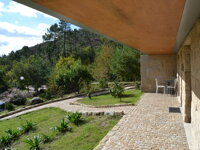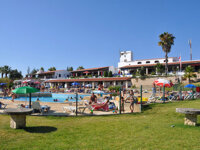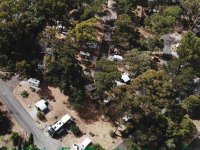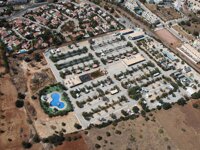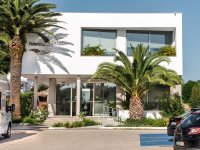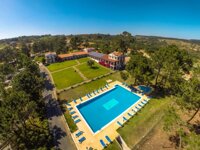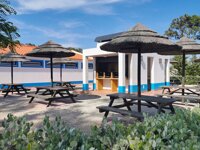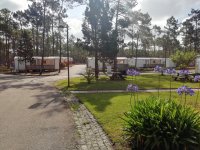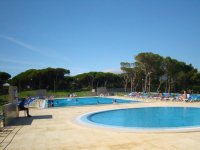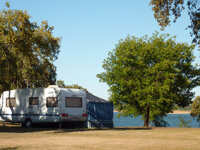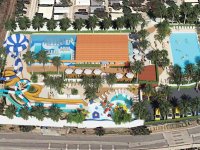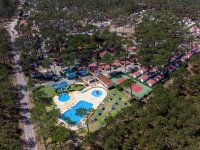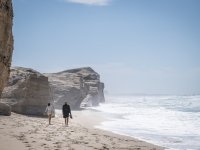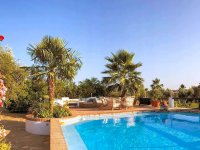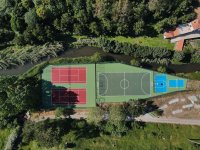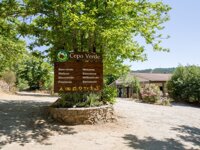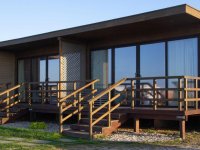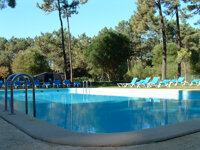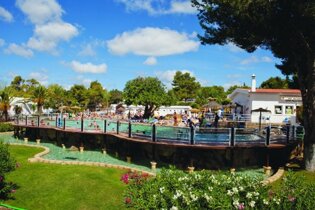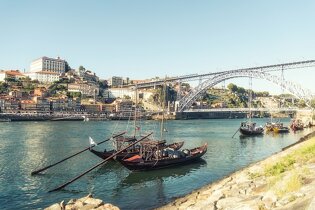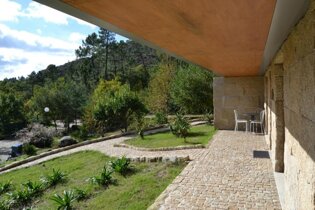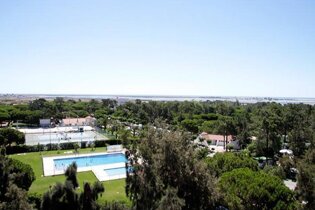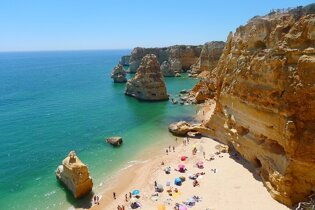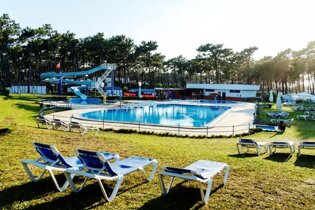Camping in Portugal
60 campsites in Portugal
Campsite Listing Google Map
The following consent is required:
Tracking & performance, Targeting & advertising.
Camping in Portugal
Our assessors have approved over 50 campsites throughout Portugal, from basic campsites through to four-star full-service family campsites with excellent facilities. Tents, touring caravans, campervans and motorhomes are welcome, though it’s worth checking in advance if planning to arrive with a large unit.
Unknown matrix block type: tableOfContents2!
Wild camping in Portugal is permitted, but there are restrictions, as well as the obvious usual responsibilities to adhere to. Some keen surfers set up camp near their favourite beach or park up together in informal groups on the cliffs to make the most of the atmosphere and be sure not to miss the best waves.
Regions of Portugal
Portugal is the westernmost point of Europe, situated on the Iberian peninsula, bordered by Spain in the north and east, with the Atlantic coast in the south and west. Despite its relatively small size, Portugal is a powerhouse of cultural and historical variety, with a rich cuisine, unique wines and distinctive traditions.
The Algarve is the annual destination for some ten million sun seekers and water sports enthusiasts who love its sheltered sandy beaches and clear Atlantic sea. Check out our Exploring Southern Portugal road trip for more inspiration. In contrast, the lush hills and forests of central Portugal are home to historic buildings and magnificent monuments, particularly Lisbon, set on the River Tagus estuary and the capital city.
Lisbon’s history can be seen still in the Alfama Quarter, which survived the devastating earthquake of 1755. By night the city is alive with vibrant cafes, restaurants and bars.
To the southeast, the land stretches out into vast landscapes of undulating plains with cork plantations and hilltop forts. Évora is a popular destination for its stunning ancient history, convents, marble fountains and Roman temple. There is so much cultural wealth here that the whole town is recognised as a UNESCO World Heritage site.
To the north lies the Minho area, one of Portugal’s most beautiful regions, home to a glorious National Park and not far from the famous vineyards producing port wine.
The Algarve
The popular destination of choice for beach holidays is traditionally the Algarve. With turquoise waters and long sandy beaches backed by cliffs, it is also known for its golf courses and balmy weather. There are plenty of decent Algarve campsites.
The Algarve coast runs for over 150 miles and features golden beaches and weather-beaten rock formations. The regional capital is Faro, with the fishing port of Lagos an important city too. The 1755 earthquake caused huge damage, but the character of the streets and elegant squares remains intact.
Within easy walking distance are superb beaches, including Praia do Dona Ana, one of the most picturesque, and the smaller coves of Praia do Pinhão and Praia Camilo. The hills to the north mark the edge of the lush interior region where fig trees, orange groves, and almond trees thrive.
Here there are ancient villages full of rural traditions and the walled town of Silves with its Moorish fortress and 13th-century cathedral. Monchique is an old spa town perched on a steep hillside with narrow streets and marvellous views.
Lisbon and Vale do Tejo
Lisbon is a great world city, with deep-rooted cultural traditions and many influences from all over the world. It has been the capital since 1255 and includes the characterful quarters of Alfama, Belem and Mouraria, bustling streets and villages within the city. Nearby is Sintra, backed by the Sintra-Cascais Natural Park.
Cabo da Roca is Europe’s westernmost point, and nearby are attractive little towns like Peniche, Nazaré and Obidos, with tiny streets of white-washed houses and balconies brimming over with flowers. History dominates, with brooding castles at Santarém, Leiria and Tomar and monasteries at Alcobaça and Batalha.
The Alentejo
With its four key districts of Beja, Évora, Setúbal and Portalegre, this is a region of epic proportions. With 30% of the country’s land mass, yet only 6% of the population, this is a vast, sparsely populated area. It is dominated by endless plains of sunflowers, a carpet of wildflowers in spring, cork oaks and olive groves. Ancient hilltop villages bask in the sun, narrow little cobble lanes linking white-washed houses with the castle and cafés where old men sit and talk in the shade.
The Alentejo is a region steeped in history, from Neolithic man who created the numerous dolmens and standing stone formations that litter the countryside, some older than Stonehenge, to the Romans, Moors and Spanish.
The Alentejo coast is wild and beautiful to the south, with some of Portugal’s best and emptiest, beaches – try Santiago do Cacém or around Vila Nova de Milfontes. The surfing here is world-class, attracting serious surfers and surf competitions from around the world.
Beiras and Centre
Flanked by Portugal’s two main rivers, the Douro and the Tagus, this is a region of fine, sandy beaches, fishing villages and pine forests along the coast and an interior of some of Portugal’s wildest terrain and highest mountains. Coimbra is the capital, one of Europe’s oldest university towns.
Porto and the North
Renowned for its stunning scenery, with the river Douro meandering slowly towards the Atlantic coast, Oporto is renowned for its wines. The home of port, as well as Vinho Verde, the region has long had an affinity with Britain. Porto city is the centre of the port wine trade, and there are terraced vineyards across the Douro Valley. It’s a place for walking, canoeing and relaxing in spa towns like Carvalhelhos, Chaves and Pedras Salgadas. Vidago is well worth visiting, while the mountains of Peneda, Soajo and Gerês form the Peneda Gerês National Park.
A brief Portuguese history
Portugal’s history is a colourful mix of settlers from the Celts, Phoenicians and Romans who constructed important tools of empire like the temples and important farming estates.
From 711, the Moors left a hugely important legacy which persists today in the language, architecture and cuisine. In the 14th century, Portugal became a major power in the Age of Exploration. Vasco da Gama, Magellan and Dias were pivotal in raising Portugal’s international profile and ensuring lucrative access to gold, trade and minerals.
The cuisine of Portugal
The best of Portuguese cuisine is often when it is at its simplest: incredible breads made with grain from the Alentejo plains, fresh grilled sardines, cheeses from Serpa, olives and sensational wines. The Moorish influence is pronounced with almonds and citrus, and there is an amazing array of rice-based puddings (often with cinnamon and other spices), tempting cakes and pastries – not least the pastel de nata, the irresistible custard tarts.
Portugal at a glance
Climate
The country enjoys a maritime climate with hot summers and mild winters with comparatively low rainfall in the south, heavy rain in the north.
Language
Portuguese, but English is widely spoken in cities, towns and larger resorts. French can be useful.
Finance and currency
Currency: The Euro (€)
Bank Opening Hours: Mon-Fri 08.30-11.45 and 13.00-14.45. Some large city banks offer a currency exchange 18.30-23.00.
Shop Opening Hours: Mon-Fri 09.00-13.00 and 15.00-19.00. Sat 09.00-13.00.
Public Holidays
- New Year: 1st January
- Carnival (Shrove Tuesday), Good Friday, Corpus Christi
- Liberty Day: 25th April
- Labour Day: 1st May
- National Day: 10th June
- Assumption: 15th August
- Republic Day: 5th October
- All Saints: 1st November
- Immaculate Conception: 8th December
- Christmas: 24-26 December
Please note Some dates are moveable, so please check before travelling.
